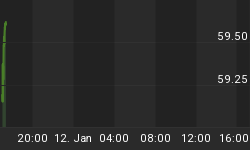Companies have started to report third quarter earnings. With the economy facing various crosscurrents, earnings will be able to shed light on the strength of different sectors. It will also be important to see which companies are able to pass along higher costs. So far there have been 130 S&P 500 companies that have reported third quarter earnings. Overall, earnings have been better than expected with 67.7% exceeding estimates and 18.5% missing analysts' forecasts. However, aggregate earnings are lower than forecasts. A large portion of this shortfall, if not the entire difference, is likely due to the larger than expected loss from General Motors. On Monday, General Motors reported a third quarter loss of $1.92 per share, far surpassing the loss of $0.87 analysts were expecting. The automaker also announced that it had reached a tentative agreement with the United Auto Workers to lower healthcare costs. The company said that it will lower its cost structure by $8 per share. While the stock jumped by 7.5% on the day of the announcement, several analysts were not impressed. Ronald Tadross, analyst at Bank of America, wrote that "only $1-$2 is incremental and offset by worse than expected 2005 performance."
Retail sales increased 0.2% in September. This was lower than the 0.5% increase economists expected. Most of the weakness was due to a 2.8% drop in auto sales. Excluding auto sales, retail sales increased 1.1%, which was better than the 0.8% gain expected. On a year-over-year basis, retail sales increased 7.1%, which was the slowest since May. Excluding auto sales, which were down 5.0% from last year, sales increased 10.6%, which was only 0.1% slower than retail sales last month. Sales at department stores were the only other area that didn't increase sales from last September.
Inflation is heating up. The Labor Department reported that the Consumer Price Index rose 1.2% in September and was 4.7% higher than a year ago. It was the highest monthly increase since January 1980 and the highest year-over-year increased since 1991. Obviously, a large part of the increase was in energy. Excluding food and energy, consumer prices increased only 0.1% from August and 2.0% from last year. Producer prices also jumped in September. Producer prices increased 1.9% from August and 6.9% from last September. Both were the largest increases since the 1990.
The ability of companies to pass along higher prices is the $64,000 question. We have detailed several companies that have been able to pass along price increases. It is also important to keep in mind that several companies have not experienced an increase in raw materials because of long-term supply contracts. During its conference call, Hasbro said that it locks in prices at the beginning of the year. It did say it will experience higher prices next year when the existing contracts expire. Hasbro also noted that since it introduces a lot of new products every year it is easier for them to raise prices. Instead of having to raise prices on existing products, new products are introduced at higher price points.
We have discussed the furniture makers several times over the past couple of years. It just keeps getting worse. This week La-A-Boy and Stanley Furniture announced earnings would be lower than analysts expect. La-Z-Boy said it expects to lose $0.17-$0.21 per share for the quarter ending this month. Analysts were expecting that much in profit. The company blamed materials shortages, especially foam, along with slower retail sales. Stanley reported third quarter results that were at the low end of guidance and said fourth quarter earning would be about 20% lower than estimates. The company now expects fourth quarter sales growth to be in a range of -2.1% to +1.5%. Analysts were expecting sales to increase around 6%.
The homebuilders have come under pressure lately. Three of the large homebuilders have reported third quarter earnings that exceeded analysts' estimates. Ryland earned $2.39 per share during the third quarter, a dime better than analysts were expecting. Homebuilding revenue increased 21%, with pricing up 8% and volume up 12%. The company said that it expects earnings will increase 15% in 2006. It appears the CEO is spending too much time watching the company's stock price. During the conference call is said, "You know, I took a poll of 7,000 public companies last night, and they said they'd be ecstatic to have 15% growth next year."
On Wednesday, the Federal Reserve published the latest Beige Book, which said "Service activity expanded in almost all the Districts." This is a departure from the ISM non-manufacturing survey which showed a significant drop in business activity. Manufacturing activity was also strong with only the St. Louis district reporting mixed reports and the Atlanta district, where businesses are still recovering from the hurricanes. Commercial real estate has been recovering for several quarters and every district reported strength for office, retail, or industrial space. In a clear departure from previous reports, residential real estate was mixed. While demand remained high, several districts noted that housing demand slowed. Labor markets were also characterized as tight with gains in the financial sector noted by several districts. Also, truck drivers are in high demand. Most districts said that wages gains have been "moderate," but a few said that wages have increased "briskly" or "noticeably." The latest focus on inflation is not misplaced. All twelve districts reported "a pickup in cost pressures from the recent increases in the prices of energy, petroleum-based products, and shipping." The ability for companies to pass along higher costs remains mixed.
Investors have a lot to focus on. While consumers have yet to curtail spending, there are several events that will likely weigh on household budgets this winder. Higher energy prices are the most discussed. Consumers will also face higher debt payments as interest rates continue to increase and the new regulations that increase the minimum credit card payment.















